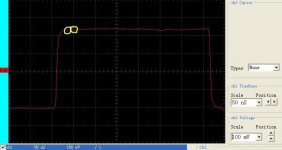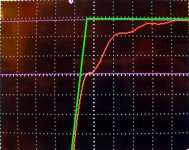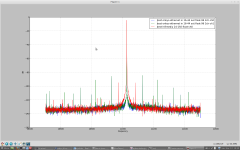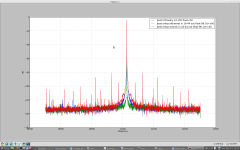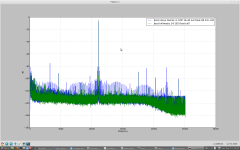I assume this is a typing error?
Jan
Ups, yes, my mistake, I'm sorry. It will translate into uS (micro-Seconds), not mili-Seconds.
Sorry, I didn't realize all you cared about was square wave measurement on S/PDIF, and not what audible effect it might cause. Most of us don't actually listen to multiple-MHz square waves
Yes.
Some of us look @ MHz square waves and listen to audio frequencies 😀
We can always discuss, what is audability of those two glitches. Especially with short cables, where those two glitches could have affected rising edge of the signal 😀
Attachments
We can always discuss, what is audability of those two glitches.
Yes, let's do that.
Especially with short cables, where those two glitches could have affected rising edge of the signal 😀
And what effect do you think the glitches have on the timing and value of the received data?
SY said:Are you familiar with the published work on the audibility of noise and distortion due to jitter?
Yes, I am impressed by knowledge of those sharp minds like Malcolm Hawksfords & others.
Impressed by practical knowledge & experience from Jocko and others who are measuring S/PDIF for decades.
Impressed, how small changes and improvements are still audible, even speakers producing several % of distortion, which should swamp all those minor things.
Not impressed by people, who only discuss things in theory and rejects everything outside their pattern of thinking.
They should try things in practice, maybe will they hear difference, maybe won't. But ad least they tried.
Yes, let's do that.
And what effect do you think the glitches have on the timing and value of the received data?
real measurement, magnified picture bellow. Short cable, impedance mismatch influencing edge. Ideal waveform (theoretical) marked with green line.
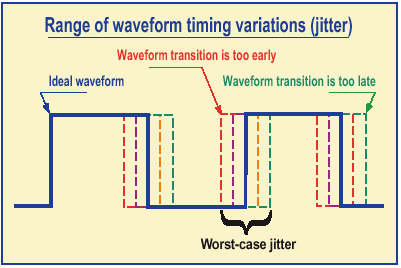
Attachments
Not impressed by people, who only discuss things in theory and rejects everything outside their pattern of thinking.
They should try things in practice, maybe will they hear difference, maybe won't. But ad least they tried.
I totally agree. Instead of rejecting everything outside their pattern of thinking, people should try things in practice - do some controlled blind testing so they realize the power of expectation bias, do some measurements to find out what is real and what isn't, but above all, look for actual evidence instead of accepting dogma (and their own infallibility) on faith.
real measurement, magnified picture bellow. Short cable, impedance mismatch influencing edge. Ideal waveform (theoretical) marked with green line.

Real measurement? Of what, using what equipment?
I think your point is a good one, but I wouldn't disparage theoreticians like Hawksford. Or bright people like Jocko focused tightly on the things they know extremely well, but aren't terribly important to the system as a whole. We learn a lot from them; once targets are determined, they give us the criteria we need to engineer to meet those targets.
But indeed, the practical guys with experimental results on audibility are the ones who set the targets, and there's not much (if any) audible differences as long as jitter at the DAC is held to less than a nanosecond or so, depending on its spectrum. Listening tests may not be your gold standard, but please understand that many people feel that the goal is an audibly transparent system, not scope pictures that are judged by eye. For those folks, once jitter is below the point where there's audible changes in the analog output, then it becomes a non-worry.
The paranoia around the "jitter" buzzword does sell magazines and equipment, so there's that.
But indeed, the practical guys with experimental results on audibility are the ones who set the targets, and there's not much (if any) audible differences as long as jitter at the DAC is held to less than a nanosecond or so, depending on its spectrum. Listening tests may not be your gold standard, but please understand that many people feel that the goal is an audibly transparent system, not scope pictures that are judged by eye. For those folks, once jitter is below the point where there's audible changes in the analog output, then it becomes a non-worry.
The paranoia around the "jitter" buzzword does sell magazines and equipment, so there's that.
Real measurement? Of what, using what equipment?
I think he meant the scope trace under that, which is entirely unrelated to jitter.
I think he meant the scope trace under that, which is entirely unrelated to jitter.
Ah, yes.
I would like some measurements, to see how bad it is. I would suspect minimal as neither waveform is that bad for digital.
As for jitter on DAC/ADC clock it has many effects.
Most commonly cited are the usual suspects :
- Create sidebands if playing a pure tone with periodic jitter (if jitter is not periodic, it creates skirts)
- Raise noise floor.
If an opamp produced a distortion spectrum with spikes like about 1ns jitter does to a DAC, it would not be marketed for high quality audio...
But.....
If you got a modern DAC with digital oversampling (64-128x) followed by a S-D modulator/noise shaper and a 4-6 bit DAC at the output ... well ... all this machinery relies on the output DAC to have at least some linearity...
Adding jitter is a bit like randomizing your FIR coefficients in real time... alias rejection doesn't work so well anymore. The guys at Benchmark clocked their ADC direct from a SPDIF receiver, you can look at the results... in the case of a DAC, it would send HF to the output opamps, causing intermodulation etc.
Also if the guys at, say, ESS, think they need to put a 20-something MHz 6-bit DAC in their chip, there is probably a reason for that considering the cost... Now, if the modulator outputs one value every 50ns, 1ns jitter kind of looks like a much bigger error (>1LSB at 6 bits...)
Marce, please, please get a scope. Borrow it...or anything, just try to get it. Preferable 100 MHz or more. It will be much easier if you could see thing with your eyes, one afternoon will show you more than reading forum for years. Ad least valid for me, since I am sceptical practical guy, need to see things with my own eyes or hear with my own ears or touch them with my own hands in order to believe.
I don't do computer memory I do PCB design fro a variety of systems that involve high speed digital, analogue Rf etc, we do simulation and also get to see the results on scopes etc.
As I do ADC and DAC designs for some very high tech stuff, that is why I am sceptical about some of the claims.
Ups, yes, my mistake, I'm sorry. It will translate into uS (micro-Seconds), not mili-Seconds.
Yes.
Some of us look @ MHz square waves and listen to audio frequencies 😀
We can always discuss, what is audability of those two glitches. Especially with short cables, where those two glitches could have affected rising edge of the signal 😀
😕
Read some Howard Johnson stuff on signal integrity.
ha that joke stuff about a 1.5m cable for best SPDIF transmission, LOL
Oh the answer is again:
ZERO
Are we talking non-monotonic rising and falling edges?
Again if you want to understand digital signal integrity this is the first stop:
https://www.sigcon.com/
http://bethesignal.com/
Getting the signal to the DAC is no problem (or shouldn't be) what comes out of the DAC is important..
Last edited:
> what comes out of the DAC is important..
Well, about that...
I've got this ONKYO TX-NR 905, expensive, heavy HT receiver ; it has an ethernet port and can play files from the network. Not a very useful functionality since it uses DLNA/uPNP (which is crap) and only plays WAVs.
I was wondering why it sounded so atrocious when using the network play, while sounding excellent with the vinyl input... and average with the HDMI.
Turns out they just slapped a mini-PC-in-a-box in the chassis (a RISC based single board computer actually) with a PCI sound chip in it, which outputs SPDIF, which is then routed to the SPDIF inputs. There are other factors to the extremely bad sound quality (even the laptop sound chip is better), notably the horrible internal signal routing (all connectors have 1 ground pin, the SPDIF/I2S go through over 9000 connectors and snake through all the boards, the poor PCM1796 are on a double sided board with no ground plane mezzanined on the DSP board with its noisy DDR bus 1cm below, etc, etc).
Attached image is FFT of the traditional JTEST signal, played as a WAV from the network, taken from the "Preamp Out", and digitized by my PC motherboard sound chip. I throw in a 30€ Hifimediy DAC for comparison to this €2000 receiver.
I won't say I can hear all those jitter spikes, but I find it quite ironic that a crap motherboard sound chip can clearly measure the difference between a top of the line piece of gear and a cheap chinese DAC........
Incidentally the Hifimediy sounds much, much, better. It is listenable, the boat anchor isn't.
Well, about that...
I've got this ONKYO TX-NR 905, expensive, heavy HT receiver ; it has an ethernet port and can play files from the network. Not a very useful functionality since it uses DLNA/uPNP (which is crap) and only plays WAVs.
I was wondering why it sounded so atrocious when using the network play, while sounding excellent with the vinyl input... and average with the HDMI.
Turns out they just slapped a mini-PC-in-a-box in the chassis (a RISC based single board computer actually) with a PCI sound chip in it, which outputs SPDIF, which is then routed to the SPDIF inputs. There are other factors to the extremely bad sound quality (even the laptop sound chip is better), notably the horrible internal signal routing (all connectors have 1 ground pin, the SPDIF/I2S go through over 9000 connectors and snake through all the boards, the poor PCM1796 are on a double sided board with no ground plane mezzanined on the DSP board with its noisy DDR bus 1cm below, etc, etc).
Attached image is FFT of the traditional JTEST signal, played as a WAV from the network, taken from the "Preamp Out", and digitized by my PC motherboard sound chip. I throw in a 30€ Hifimediy DAC for comparison to this €2000 receiver.
I won't say I can hear all those jitter spikes, but I find it quite ironic that a crap motherboard sound chip can clearly measure the difference between a top of the line piece of gear and a cheap chinese DAC........
Incidentally the Hifimediy sounds much, much, better. It is listenable, the boat anchor isn't.
Attachments
I must say in the last post I was a bit unfair, since the TOSLINK connector did not fit in the Hifimediy optical output, which is actually a 3.5mm Jack LED with at the bottom, I just taped it in place, which no doubt provided some attenuation. The receiver didn't have any lock problems and data was transferred correctly though.
So, I dug up this HYUNDAI CD-DVD-MP3-USB-Piratebay player from the bottom of my stash, it seems it has a TOSLINK output, let's connect that to the ONKYO, and play a JTEST CD burned for the occasion.
This time, no need to zoom.
😱, 😱, 😱.
There is also suspicious looking hairs around 22050 Hz (only for the Onkyo)... it was there in all previous tests, wonder where that comes from... Could it be some digital crosstalk in one of the 9000 connectors with a single ground pin ?... Hm...
So, I dug up this HYUNDAI CD-DVD-MP3-USB-Piratebay player from the bottom of my stash, it seems it has a TOSLINK output, let's connect that to the ONKYO, and play a JTEST CD burned for the occasion.
This time, no need to zoom.
😱, 😱, 😱.
There is also suspicious looking hairs around 22050 Hz (only for the Onkyo)... it was there in all previous tests, wonder where that comes from... Could it be some digital crosstalk in one of the 9000 connectors with a single ground pin ?... Hm...
Attachments
Last edited:
Cost cutting and designed for home cinema, most of which I have heard in UK living rooms sound atrocious with bowel loosening one note bass.
I am not surprised, I have been dismayed by the quality inside a lot of gear when it opened up and modded on here. CEM and single sided boards, or if you are lucky double sided PCB!
I am not surprised, I have been dismayed by the quality inside a lot of gear when it opened up and modded on here. CEM and single sided boards, or if you are lucky double sided PCB!
I got this monster from an audiophile at 1/3rd the price because it has a big weakness... its HDMI ports don't support 3D  . The guy raved about the sound, I should have known better.
. The guy raved about the sound, I should have known better.
I dunno if it is about cost-cutting, the thing looks expensive to build... also those DACs aren't the cheapest ones (even though all opamps are NE5532). Perhaps those guys were just used to design HT receivers from the analog era (the analog part is not bad) and just stuck some digital stuff in there without a second thought...
When using the digital inputs the sound is lifeless, boring to death, I've never tolerated it more than 5 minutes...
 . The guy raved about the sound, I should have known better.
. The guy raved about the sound, I should have known better.I dunno if it is about cost-cutting, the thing looks expensive to build... also those DACs aren't the cheapest ones (even though all opamps are NE5532). Perhaps those guys were just used to design HT receivers from the analog era (the analog part is not bad) and just stuck some digital stuff in there without a second thought...
When using the digital inputs the sound is lifeless, boring to death, I've never tolerated it more than 5 minutes...
Not cost cutting down to the bare bones. All commercial products I have worked on have a build cost, that covers everything including the packaging, and a specification, trying to meet both is the challenge. If I remember in the days before dolby DTS etc sound Onkyo were one of the top makes, like you said, they have probably clagged on the digital section.
The little add on PC boards can be an EMC nightmare in many situations, limited size, and off board connections everywhere with no room for filtering. Quite often when they are used all the connections go to some sort of filtering, with isolated power and ground, just to pass basic EMC
The little add on PC boards can be an EMC nightmare in many situations, limited size, and off board connections everywhere with no room for filtering. Quite often when they are used all the connections go to some sort of filtering, with isolated power and ground, just to pass basic EMC
I wanted to measure the HDMI input jitter too, because a look at the schematics make me think it would be quite catastrophic... MCLK comes straight out of the HDMI receiver chip... I found some figures on the net :
Onkyo TX-NR5007 AV Receiver:
S/PDIF: 0.79 ns
HDMI: 4.87 ns
Yamaha RX-V3900
SPDIF: 0.183 ns (try TOSLINK, guys)
HDMI: 7.7 ns
That's 12 bits territory...
This forum needs a puking smiley ...
Onkyo TX-NR5007 AV Receiver:
S/PDIF: 0.79 ns
HDMI: 4.87 ns
Yamaha RX-V3900
SPDIF: 0.183 ns (try TOSLINK, guys)
HDMI: 7.7 ns
That's 12 bits territory...
This forum needs a puking smiley ...
That's 12 bits territory...
Well, only at 10 kHz. At 1 kHz it is more like 15 bits - but in any case, not very good.
- Home
- Source & Line
- Digital Line Level
- Is measuring square wave on spdif cable possible?
